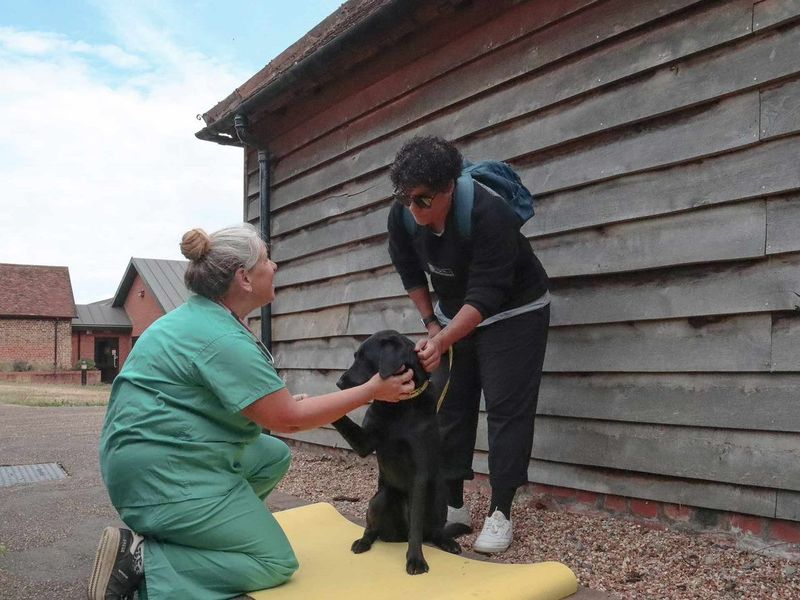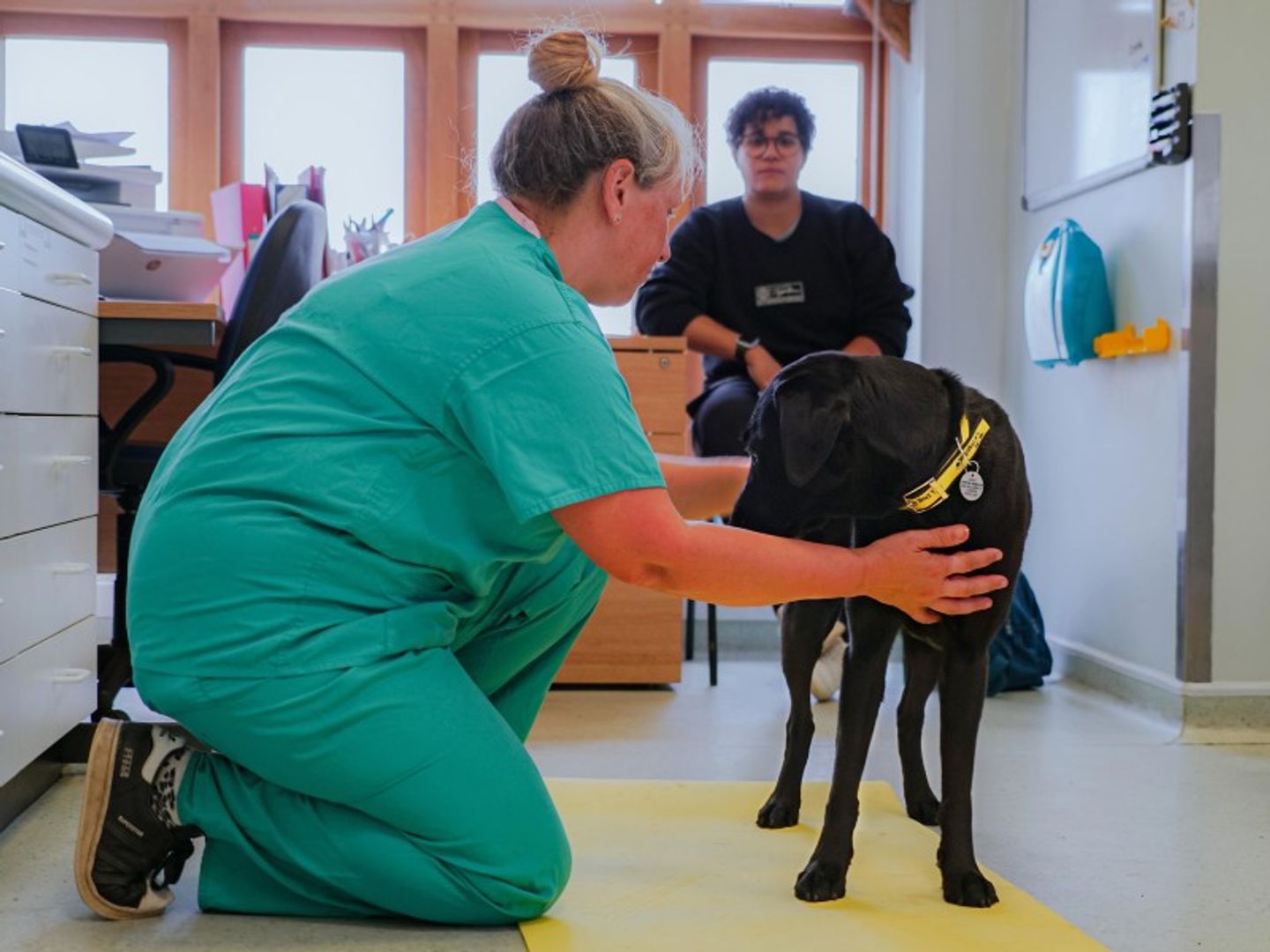How to perform a health check on your dog
Discover how to give your dog a regular home health check that will alert you to any issues as soon as possible.

We all want our dogs to be happy and healthy, so it is a good idea to check your dog over regularly. This will help you notice anything out of the ordinary straight away and seek veterinary advice as soon as possible.
Top tips for getting your dog used to a health check
Make sure your dog is comfortable being touched
First, get your dog used to being handled all over their body. This will help them to be confident in being checked over. Find out how to introduce handling to your dog in a positive way.
Use tasty treats
Dogs learn by association. If regular health checks are always accompanied by tasty treats, your dog will learn to enjoy being checked over.
Take it slowly at the beginning
Make sure to introduce health checks gradually and start when they’re naturally relaxed and calm. You could focus on one body part each day over the course of a couple of weeks, so your dog can get used to being handled on different parts of their body.
Start with …
Be consistent and check your over in the same way every time
Dogs can feel more confident and reassured when they are able to predict what is going to happen to them. It can help to do things in the same order each time you check them over.
Use a mat for your health checks
You can help your dog predict what is going to happen by doing their health check when they are on a specific mat.
Yoga mats are great because they are non-slip and lightweight so you can even take it to your veterinary clinic with you.
Over time, your …
Watch your dog’s body language
Dogs communicate how they’re feeling with their body language. Get to know what different body language means and monitor how they respond as you examine them.
They should let you know how they feel about being handled. This can also help tell you which areas of …

What to do if your dog doesn’t like being handled
Book an appointment with your vet to rule out any possible pain. Make sure you let the vet team know that your dog doesn’t enjoy being handled.
If pain has been ruled out or treated, but your dog is still worried about being handled, contact a behaviourist for support. Your dog might have had an unpleasant or painful experience in the past.
They might need help to overcome difficulties being handled on a specific part of their body, or in general.
What to look for when checking over your dog
Here’s a checklist of things to look for when examining your dog. If you have any concerns, always contact your veterinary clinic.
Watch your dog for any signs of flinching, and listen for any vocalising, when you examine them. This could be a sign that they are uncomfortable or in pain.
| What to check | What to look for |
|---|---|
General body condition and movement |
Watch your dog moving around. They should be able to:
Gently feel your dog’s body. Their body should feel the same on both sides. For example, each shoulder should feel the same size and shape, and they should be the same temperature. If you look at your dog from above, you should be able to see their ‘waist’ and their back should be straight. You should be able to feel your dog’s ribs beneath their coat, but not see these visibly through their fur. Note: this might vary between breeds and types. |
Breathing |
Watch your dog’s chest rise and fall. Their breathing should be regular and rhythmic. Your dog should breathe comfortably and without difficulty, rasping or wheeziness. |
Coat/skin |
Look for any broken skin such as cuts or grazes, as these will need to be kept clean and might need medical attention. Check for any parasites such as ticks, lice and fleas, or flea-dirt which might appear as reddish-brown flecks within the fur. Check for lumps and spots, as well as any patches of hair loss, itchiness, reddening or thickening of the skin beneath the fur. Has your dog been repeatedly scratching or nibbling at themselves? Matted fur clumps could be a sign that your dog is chewing themselves in that area, perhaps to relieve pain. Or they might be unable to reach and groom that area. |
Face |
Each side of your dog’s face should look the same, without any drooping. They should hold their head straight, without any permanent tilt to either side. Their eyes, including the pupils, should be the same size and shape. The white bits of the eyes should be white, not yellow, red, or speckly, without any yellow or green discharge. Your dog should be able to hold their ears in a natural position. Their ears should feel the same temperature as the rest of their body. They shouldn’t have any swelling or lumps. Some wax is natural, but the inside of your dog’s ear should be free from discharge and not red, crusty, or foul-smelling. Dogs’ noses can vary in colour, but they should have equal-sized nostrils which flare open and closed naturally when sniffing. |
Jaw, teeth and gums |
Your dog’s jaw should open and close without difficulty. They should be able to eat without difficulty. They shouldn’t drool constantly or repeatedly scrabble at their mouth with their paws. Their tongue and gums should appear lubricated and shiny. Gums should not be bright red or pale, grey, or white. Your dog’s teeth should not be broken or wobbly. Plaque can build up on the teeth so follow your vet’s advice regarding teeth care. |
Legs and paws |
Gently run your hands down each of your dog’s legs in turn. Running your hands down your dog’s legs first helps them to expect that you are going to move onto their paws. Take care to lift each leg with its natural movement so you’re not holding your dog’s leg awkwardly to get a look at their paws. Check for:
Check your dog’s nails for any signs of damage or overgrowth, including the dew claw if your dog has these. Find out more about your dog’s nails and how to clip them. |
Genitals and anus |
These should appear clean and not swollen or reddened (unless a female is in season, at which time you are likely to see the vulva swollen and some bloody discharge). Check for any signs of irritation and itchiness, as well as lumps or hardened areas. Contact your vet for advice if your dog is chewing at their bottom repeatedly. Both males and females have nipples – usually 10, in two rows across their whole chest area. These should not have any lumps, redness or swelling. If there are any changes, take a photo if easy to do for reference and monitoring and contact your vet for advice. |
Tail |
Your dog’s tail should be held naturally and move easily. Check for any areas of damage, swelling, greasiness, hair loss or chewing. |



